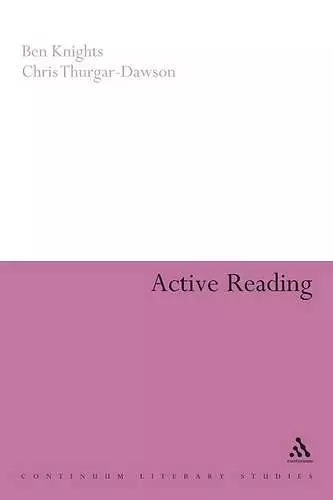Active Reading
Transformative Writing in Literary Studies
Professor Ben Knights author Dr Chris Thurgar-Dawson author
Format:Paperback
Publisher:Bloomsbury Publishing PLC
Published:1st Jun '08
Currently unavailable, and unfortunately no date known when it will be back

This book makes a practical case that re-writing should be a core activity for English students, complementing analytical activity, and providing bridges between creative writing, media studies, and traditional forms of reading and criticism.
Highlights the value of creative and re-creative transformational writing in learning and teaching and provides practical examples of its application. This book outlines the importance of writing as a medium of learning and argues for its usefulness in aiding English students' understanding of theoretical as well as literary and cultural texts.This book highlights the value of creative and re-creative transformational writing in learning and teaching and provides practical examples of its application.The subject of this book is the crossover between critical study and creative writing. 'Active reading' is a structured process of writing activities using imitation, variation and experimentation. Through practical composition techniques such as 'transformational writing', 're-writing' or 'translation', students can use writing activities to develop their critical imagination.This book bridges the gap between theories of learning and Literary studies in Higher Education. Setting the argument in an historical and theoretical context, it outlines the importance of writing as a medium of learning and argues for its usefulness in aiding English students' understanding of theoretical as well as literary and cultural texts.The authors provide a reflective account of teaching and assessment methods using writing activities and critical thinking techniques and the forms of learning they promote. In the last section, they explore the connections with other forms of writing practice in related disciplines and argue for the role of transformational writing in promoting independent learning.Appendices provide examples of the range of activities that can be used and an indicative list of literary examples.
"'This is an important book, valuable in the first instance not only to student teachers and NQTs but also to those teaching in HE who need convincing of the value of using transformative writing as a literary tool...The enthusiasm of both students and teachers comes across clearly. There is a wide variety of examples given not only of students' writing in response to specified passages and authors but also, and very revealingly, of the ways in which this writing was assessed...' Adrian Barlow, Newsletter of The English Association. '...a terrific addition to any English department. It describes a practical rather than theoretical route to understanding English literature. The writing is meticulous, thoroughly researched and trustworthy...This way of learning makes sense to me...In many ways, this is the bridge-building book...between creative writing and literature, between the elitism of the critics and the writing process and between all the other disciplines that could benefit from this approach. I would recommend it.' Rosie Garner, Lapidus Autumn 2007"
ISBN: 9781847062635
Dimensions: unknown
Weight: 316g
208 pages